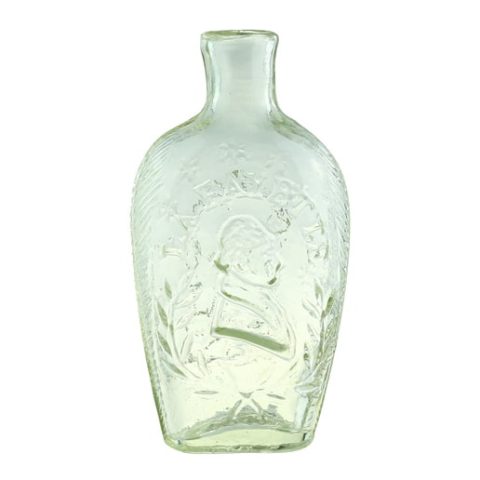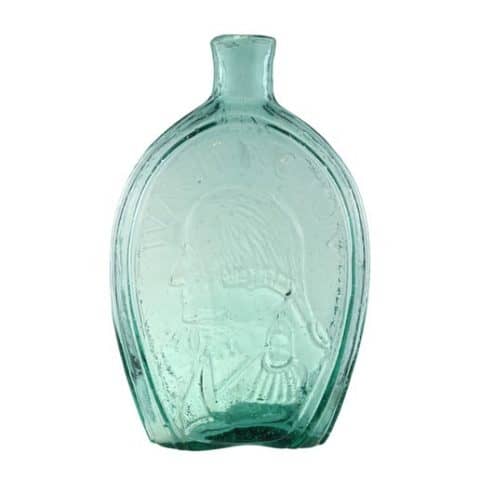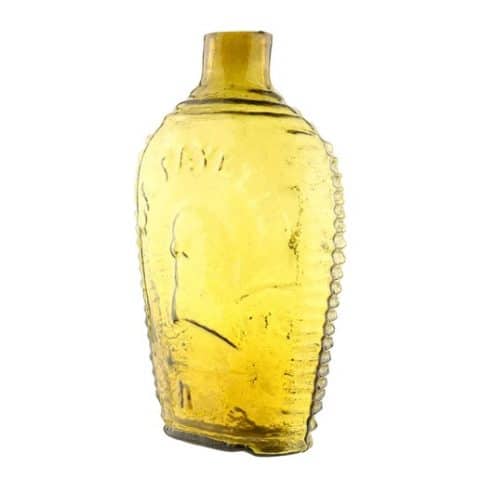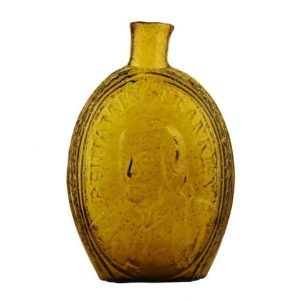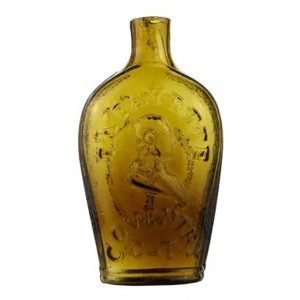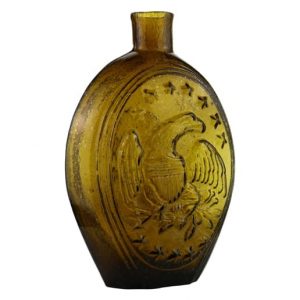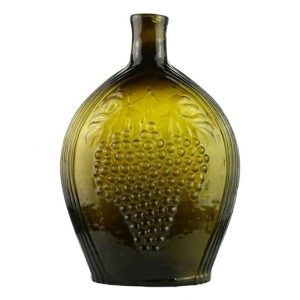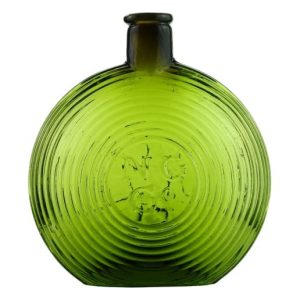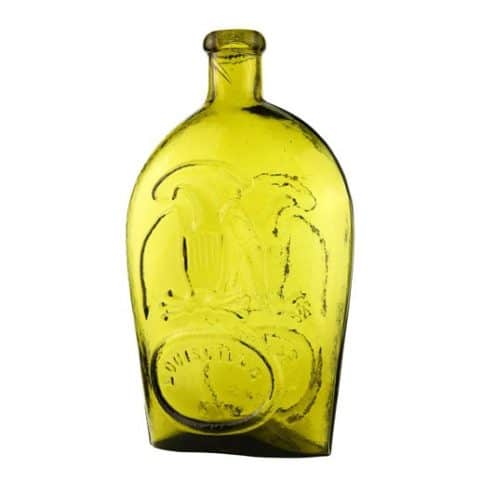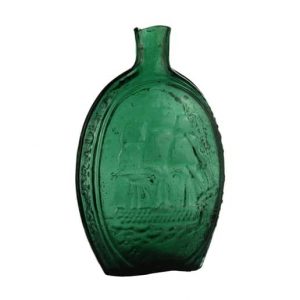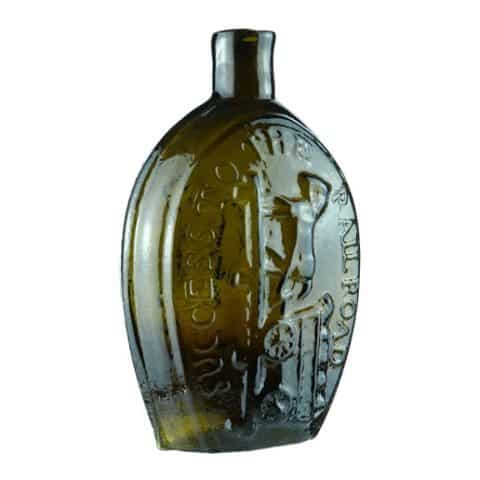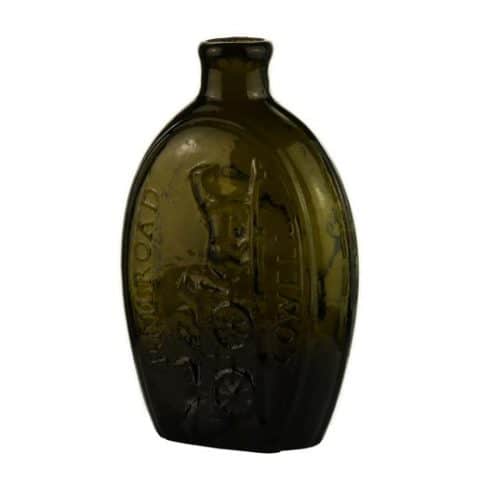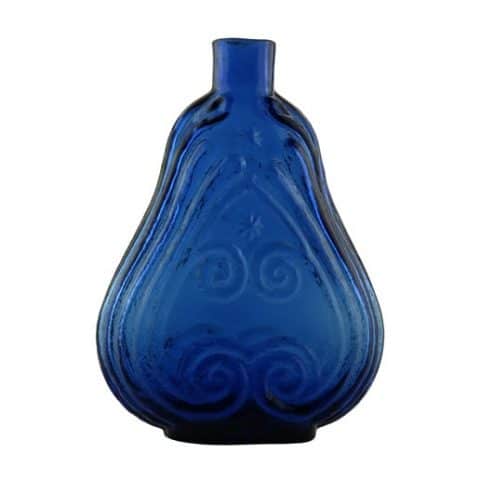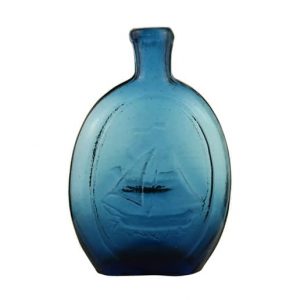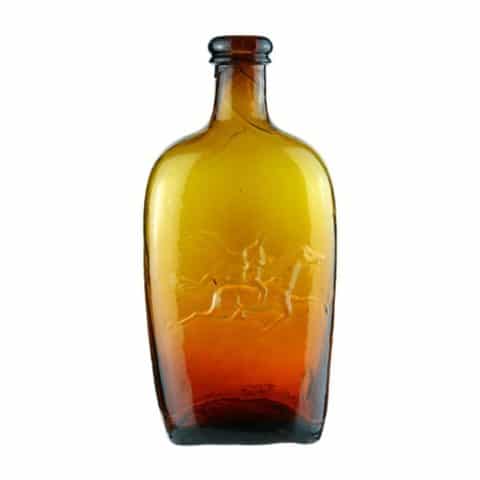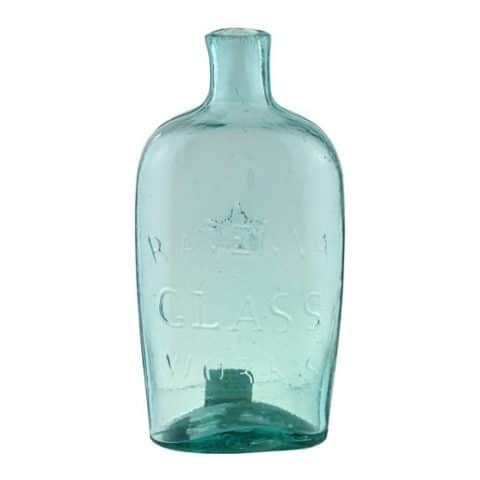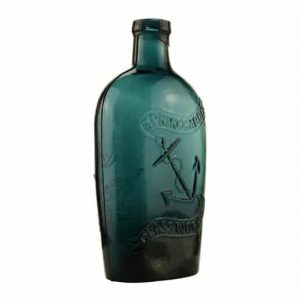GIV-8 Masonic Arch and Emblems – Eagle Flask
GIV – 8
Masonic Arch and Emblems – Eagle
Historical Flask
Attributed to Keene Marlboro Street Glassworks
Keene, New Hampshire
Emerald Green with Puce Striations Pint
Provenance: Anonymous

Our museum example of a pint GIV-8 Masonic Arch and Emblems – Eagle flask has essentially the same obverse and reverse sides as our GIV-7 Masonic Arch and Emblems – Eagle pint that is also represented in the museum. The primary difference occurs within the beaded oval frame with the eight-pointed star that is different than the star used on the GIV-7 flask.
This extraordinary emerald green flask has puce striations and is ex Sam Laidacker and Tom McCandless collections. Our secondary example in pale blue-green is ex Charles B. Gardner and, Robert and Janice Weekes collections.
See the museum examples of GIV-7 Masonic Arch – Eagle flasks.
In the McKearin American glass historical flask charts, the “heavy Masonics” are considered to be the GIV-1 through GIV-15 listings. Most glass scholars and collectors believe them to be one of America’s first historical flasks that were made during or just after the War of 1812. Based on research and archaeological digs, heavy Masonic flasks have been attributed to the Keene Marlboro Street Glassworks in Keene, New Hampshire, the New England Glassworks in Temple, New Hampshire, and the Mt. Vernon Glassworks in Vernon, New York.

In 1717, the first Grand Lodge, an association of lodges, was founded in England, and Freemasonry was soon disseminated throughout the British Empire. The first American Mason lodge was established in Philadelphia in 1730, and future revolutionary leader Benjamin Franklin was a founding member. George Washington joined Freemasonry in the Lodge at Fredericksburg, Virginia when he was 20 years old. He received the first degree of Entered Apprentice on November 4, 1752.
Most Masonic flasks were manufactured between the years 1810 and 1830 in the United States during the period American Freemasonry, which was considered both a fraternal and patriotic organization, was at its zenith. During this period, it was not unusual for Masonic lodges to meet in local taverns or in rooms rented for the occasion. Following the meeting, the brethren would customarily assemble for a “festive board” or collation, at which toasts were offered and libations consumed. As likely as not, Masonic flasks came into use at this time and some of these examples could have been on tables, full of spirits to propel dialog and conversation.
On what is considered the front or obverse side of the flask, there are two embossed columns rising from a mosaic pavement consisting of 28 bricks in rows of 8, 8, 4, 4, and 4. Connecting the columns is a curved archway with a central keystone. Below the keystone is an all-seeing-eye surrounded by rays. Below the rays and the eye is an open book with a compass and square forming a diamond shape. Between the columns is a radiant triangle enclosing a “G.” To the left of the columns is a trowel above a skull and crossbones. Above the trowel and to the left of the keystone is a blazing sun with rays. Below the pavement, is a beehive to the right and a crossed level and plumb line to the left. To the right of the columns is Jacob’s Ladder ascending to a radiant quarter moon with three stars above and three stars below. The stars appear as dots.

The reverse face of the flask is also similar to the GIV-7 pint. The GIV-8 flask has an embossed eagle with its head facing to the left. Above the eagle’s head is a banner or ribbon containing heavy crimping. The eagle has a breast shield with twelve dots at the top, three rows of four each representing a star. The right wing is foreshortened to give the eagle a more three-dimensional appearance. There are three arrows or thunderbolts in the right talon and an olive branch in the left talon. Below the eagle is a raised beaded oval frame that contains an eight-pointed star that is different than the star used on the GIV-7 flask.
The pint flask has a tooled lip and pontil mark. The sides are vertically ribbed with five ribs. Known colors are aqua and clear which are considered rare. Green (puce-striated), green (amber streaks), yellow-green, and dark blue-green flasks are considered very rare. The flask was probably made at the Keene Marlboro Street Glassworks between 1815 and 1830.
Primary Image: The GIV-8 Masonic Arch and Emblems – Eagle flask was imaged by the FOHBC Virtual Museum midwest studio by Alan DeMaison.
Support: Reference to American Bottles and Flasks and Their Ancestry by Helen McKearin and Kenneth M. Wilson, Crown Publishers Inc., New York, 1978.
Support Images: Auction Lot 43: Masonic Arch And Emblems – Eagle Historical Flask, probably Keene Marlboro Street Glassworks, Keene, New Hampshire, 1815-1830. Pale blue-green, sheared mouth – pontil scar, pint. GIV-8 Great provenance. Fine condition. A difficult flask to acquire in this great condition. Ex Charles B. Gardner collection, Robert and Janice Weekes collection. Norman C. Heckler & Company, Auction #164
Join the FOHBC: The Virtual Museum is a project of the Federation of Historical Bottle Collectors (FOHBC). To become a member.








